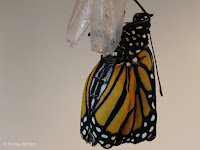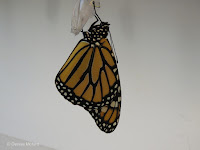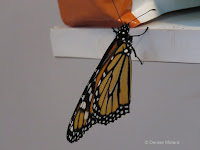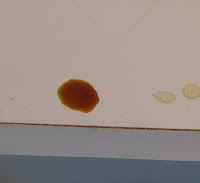EMERGING AS A BUTTERFLY
This page shows photos and videos of Monarch butterflies emerging from their chrysalis, with some notes along the way. Click here for more detailed photos of a Monarch butterfly emerging from its chrysalis.
(More general information on the Monarch butterfly can be found here.)
CHRYSALIS STAGE DURATION AND SEX
In the small sample I had the first year (15 caterpillars), I found that males spent a slightly longer time than females in the chrysalis stage – 10 days vs 9.4 days for the females.
THE WAY THE CHRYSALIS ENVELOPE CRACKS OPEN appears to always be the same, i.e. along the two inverted ‘V’ lines where the legs are. The envelope starts splitting from the base and along those lines, and the butterfly slips out head first between that flap and the rest of the chrysalis envelope. This can be clearly seen on this page, a series of detailed photos of monarchs emerging.
MALE OR FEMALE? There are different ways of finding out the sex of a Monarch butterfly. Please check this page for photos of males and females.
HEMOLYMPH PUMPING (or how the wings reach their normal size): As soon as the Monarch butterfly has emerged from its chrysalis, the abdomen, which is filled with hemolymph, starts pumping it into the wings. These then gradually reach their normal size. Here’s a video below that shows those pumping movements:
At the beginning the wings are smaller than the abdomen, shriveled and looking wet with two color tones. Then at the end the wings appear to have reached their normal size and color.
TIME OF DAY WHEN BUTTERFLIES EMERGE: Of the small sample I raised (15 caterpillars), 13 of them emerged in the morning, and the two others around mid-day. This timing is very different from the timing when the caterpillar turns into a chrysalis. The latter (again from my small sample) was spread all over the day AND evening.
WHY FOUR LEGS? Normally insects have three pairs of legs, and Monarch caterpillars do have three pairs of legs. However when emerging, Monarch butterflies are seen with only four legs (two pairs), not six. This is because the first pair is atrophied and kept close to the thorax.
PROBOSCIS AND LABIAL PALPS: As soon as the Monarch butterfly has emerged from its chrysalis, it holds onto it with its four legs while its wings are drying and enlarging. At the same time however, its proboscis and labial palps are very active.
This video below shows the proboscis uncoiling and coiling back repeatedly, and the labial palps moving back and forth laterally in rapid fashion. The proboscis tip looks forked, but it is actually made of two tubes which suck nectar from flowers. As for the labial palps, they are sensory organs and also protect the eyes.
The video below shows how the Monarch butterfly emerges from its chrysalis. The moment the abdomen slips out is critical due to its weight. The butterfly had better hold onto the chrysalis solidly with its four legs to absorb the ‘shock’ of that heavy abdomen suddenly hanging down. The legs end with two claws each for that purpose.
These photos below of a male Monarch were taken at different intervals following the above video. They illustrate how the wings grow to their normal size as they are being filled with hemolymph pumped into them from the abdomen. As the wings expand, the abdomen shrinks to its normal size.
 |
| Monarch male at 10:43 am |
 |
| Two minutes after |
 |
| Three minutes after |
 |
| After 7 minutes |
 |
| After 8 minutes |
 |
| After 19 minutes |
 |
| After 47 minutes |
 |
| After 3 hours, showing orange drippings |
 |
| Starts to move after 3 hours |
 |
| Takes more 'steps' after 4.5 hours |
 |
| Meconium drippings after 45 min. |
 |
| Meconium drippings after 4 hours |